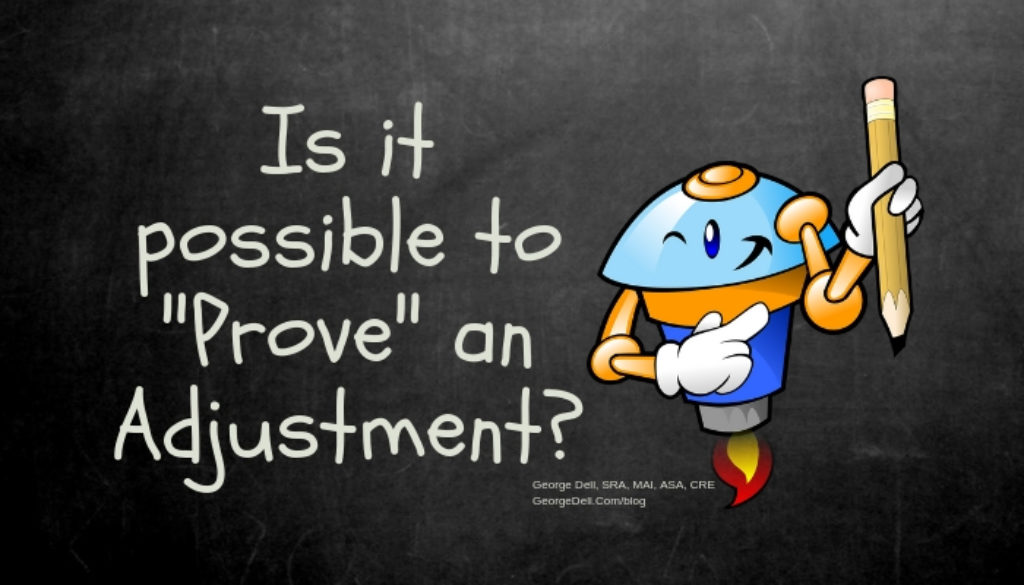We read articles and advertisements on how to prove an adjustment. Is this possible?
How wonderful it would be. To prove an adjustment, just push a button and bam! Out comes the correct answer. How could we have we missed this?
Of course, if such a simplistic and exact answer was possible – anyone could push that button. An AVM run, a BPO agent, an “evaluator”, or anyone else. Who needs all that USPAP competence and integrity stuff? Even a lender-appointed hybridized “field inspector” could just push the button.
The whole process could even skip working with the licensed appraiser completely! Except there’s sometimes still a need for a signed certificate attesting to the believability, trueness, correctness, unbiasedness, and independence of the “opinion.” Would this be a problem?
How hard is it to find a licensed appraiser to sign? In recent years we saw a surge of new appraisers with little training, but able to fill out the form and sign. Now the Appraisal Qualifications Board (AQB) has reduced the requirements for licensing. This is reasoned as a way to better provide for our “public trust” with the speed, low price, and client expectations. What could be better?
And best of all, we checked – they have the required “Errors and Omissions” insurance. A number, a guarantee, and speedy service. No need to deal with those slow appraisers who claim they need time to provide good work and a truly independent, impartial, and objective opinion. Good or bad, they all certify to their competence and ethics. Heck, it’s just an opinion anyway. And there’s no opinion or measure of reliability. Just credibility – trust me, please believe me. Don’t ask, don’t tell. Shhhh!
Just an opinion. But prove the adjustments. No problem – just push the button.
What is a possible truth? In data science, we estimate adjustments. We can contrast or associate quantities from “comparables”. We can sometimes get a hard number. But it will always, always have a level of reliability – sureness, variation, or uncertainty.
Appraisal is the only discipline or profession I know of that does not provide a level of certainty around a point value, or even a range of value. This is the core downfall of the profession.
In Valuemetrics.info classes we consider this fallacy and weakness. We build the scientific foundations of the art and science of valuation. The results are “predictive models” of value. (Just as it specifies in The Appraisal of Real estate, p.736, 14th ed). Predictive models inherently recognize uncertainty.
In Stats, Graphs, and Data Science classes, we specify three analytic adjustment results:
- Deterministic, where given the data set and model, the result is exact.
- Estimated, where the result is probabilistic, with a measure of sureness.
- Asymptotic, where we know the result is biased, but useful.
If we understand these three types of estimation models, we can fit any situation, any property type: residential and amenity, investment and speculative, agricultural and land. The data science tools and techniques are universal.
The future of the valuation profession depends on realizing one fact: The world no longer has much use for a point value of unmeasured reliability of two weeks ago. The world and the public trust need much, more. Much more can best be provided by appraisers competent in the art and the science, and an understanding of the interface of computation and human brain, and how to seamlessly integrate the modified data stream into client software and business systems.
Will our GSEs, professional organizations, clients, regulators, and legislators encourage this progress, or stay with the old system, where the appraiser says: “Trust me, I know a good comp when I see it!”

October 3, 2018 @ 9:08 am
Great article. The definition of Market Value itself uses the work Probable, which in itself indicates that there is a range within which it exists, not an absolute value.
Back in 1982 or so, the definition changed from the “Highest Price” measurable to the “Most Probable” price. Our industry did a much better job measuring the highest price possible, than the most probable.
Some of the things I work on have a very wide range of probability, others it is very narrow. When doing remote land appraisals, there is often a huge range in value indicators, some of which we simply cannot find out about.
When appraising a home in a tract with 100 homes and 4 models and 20+sales per yer, the most probable range can be quite narrow, especially in a hot market.
When the definition of Market Value changed in 1982, I began adding a range indicator to my point value estimates, like +-5% or 10%, etc.
For some clients, they want the exact range, a high, low and most probable number. They use these for negotiating purposes.
Lending clients want one number, and the forms required do not provide a place to enumerate the probability of that number or the range which is relevant.
George, If I don’t see you before, I will see you in Fresno next month. I think If I take your class one more time, I might actually get it.
October 4, 2018 @ 5:28 am
George, After your visit to South Carolina, I find myself , again, opening up to where the profession is and where it should be going. I hope that we can bring you back here for our annual convention in Myrtle Beach and allow you to expand even more on these principles of Appraising!